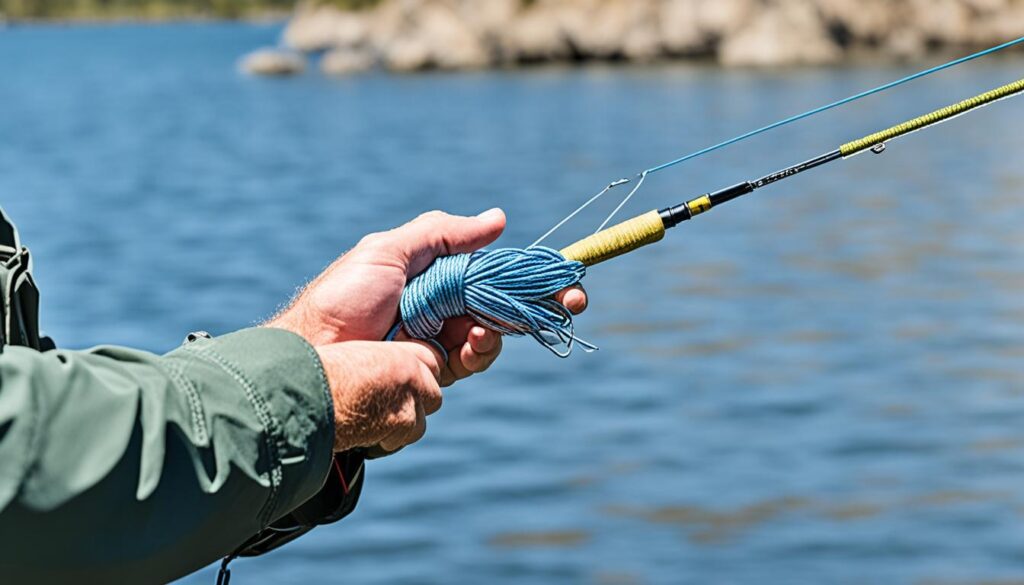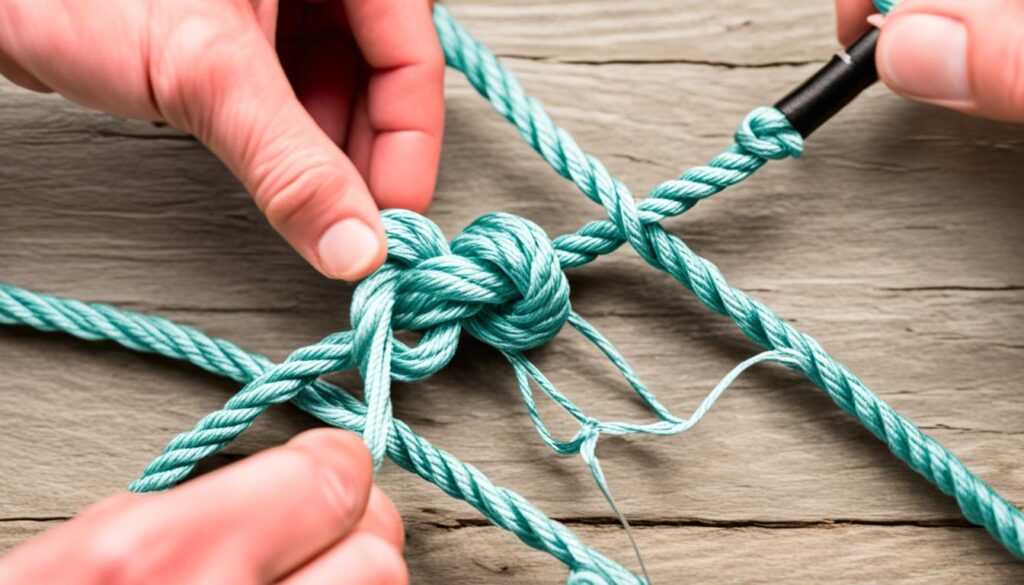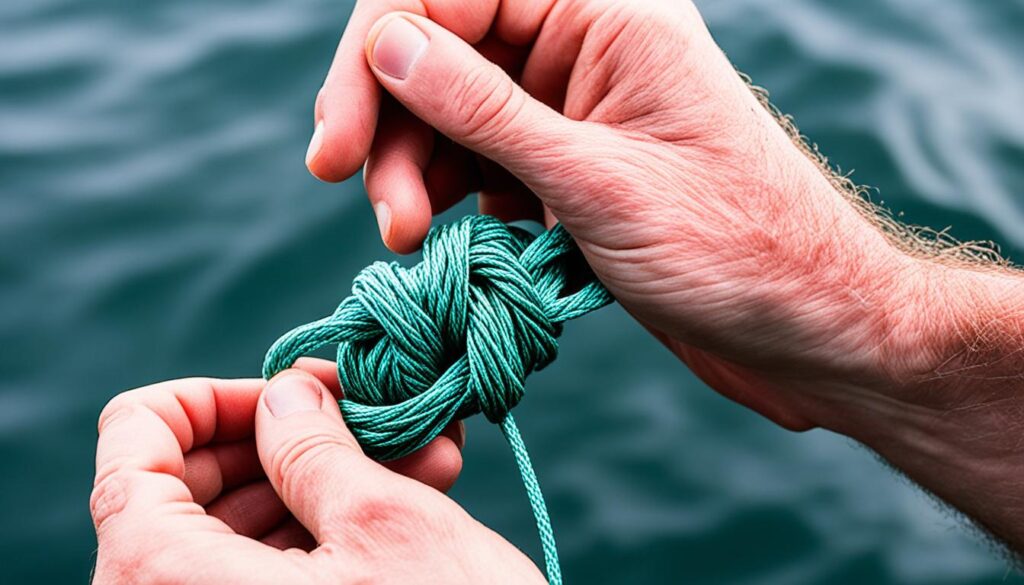Are you looking for strong fishing knots? The Palomar Knot is a top pick. It’s the favorite of many anglers for its strength. It doesn’t break easily, even when you catch many fish. Knowing how to tie it is a must for any angler.
This guide will show you how to tie the Palomar Knot. We’ll go from putting the line through the hook’s eye to finishing the knot right. You’ll also learn why this knot is excellent and tips for getting it right every time.
Key Takeaways:
- The Palomar Knot is considered the best fishing knot by many anglers.
- It is a strong and reliable knot, especially when tied properly.
- The Palomar Knot works well with braided fishing lines and is often used with the Ned Rig fishing technique.
- It is known for its durability and resistance to breaking when catching multiple fish.
- Learning how to tie the Palomar Knot is essential for all anglers.
What is the Palomar Knot?
The Palomar Knot is famous in fishing circles for good reason. It is both solid and easy to tie. Many anglers use it to securely connect their line to the hook or lure. This knot is known for staying tight and not slipping away.
Anglers at all levels love the Palomar Knot. It works well with different lines, like braided and monofilament. Tying it is quick and straightforward. Plus, it holds well, so your fish will stay put.
You must follow a few steps to tie a Palomar Knot the right way. Make a loop in the line. Then, pass the loop over the hook or lure. After that, pull the loop over the main line and the end tag. Remember to wet the line before pulling it tight. This little step makes sure your line lasts longer.
Despite being strong, the Palomar Knot can only succeed if tied correctly. Please avoid crossing the lines when you’re tying it. This can cause friction and damage the line over time. Always remember to use enough lubrication before you finish the knot. This will make tightening it a smooth process.
Learning to tie the Palomar Knot right is key for any angler. This knot is strong, simple, and works in many fishing situations. Please make sure your setup can handle the big catch by tying it correctly.
Now, let’s go through the steps to tie a Palomar Knot correctly.
How to Tie the Palomar Knot Step-by-Step
Learn how to tie the Palomar Knot with simple steps. This knot is solid for fishing. It’s easy and quick to do. Could you follow these steps every time?
- Start by threading the line through the eye of the hook or lure. Make sure you have enough line.
- Double the line and create an overhand knot with the looped end. This is how you start the Palomar Knot.
- Could you pass the loop over the hook or lure? It should be big enough to go around it all.
- Next, flip the loop up over the main line and tag end. This step secures the hook or lure.
- It’s good to wet the line before tightening the knot. This helps it slide and secure better.
- Then, pull the main line slowly to tighten the knot. Keep the lines straight and the loop in place.
- After the knot is tight, trim the tag at the end of the line. Leave a little tail for more security.
For smaller hooks, here’s an easier way:
- Hold the tag end and make a small loop.
- Pass this loop through the hook or lure’s eye.
- Now, you can follow steps 3-7 from the standard instructions to finish the knot.
By following these steps, you’ll get good at the Palomar Knot. It’ll keep your line and hook/lure strongly connected. Keep practicing till you’re quick and sure.
With the Palomar Knot in your skills, let’s see why it’s excellent for fishing.
| Step | Description |
|---|---|
| 1 | Thread the line through the eye of the hook or lure. |
| 2 | Double the line and create an overhand knot with the looped end. |
| 3 | Pass the loop over the hook or lure and flip the loop up over the main line and tag end. |
| 4 | Wet the line and slowly pull it tight, making sure the lines are not crossed. |
| 5 | Trim the tag end of the line. |
Benefits of Using the Palomar Knot
Anglers love the Palomar Knot for several reasons. It’s a strong knot, providing a firm link between your line and hook or lure. You won’t have to worry about it slipping under pressure, offering peace of mind during fishing.
This knot shines in its ability to work with any fishing line. It doesn’t matter if you use braided lines, monofilament, fluorocarbon, or lines with waxy finishes. The Palomar Knot adapts and maintains its strength on all kinds of lines.
In contrast to other knots, the Palomar Knot keeps its strength universally. This universality confirms its reliability with any fishing line you choose. So, please just tie it with your preferred line and fish without doubts.
One of the key benefits of the Palomar Knot is its ease. Learning to tie it is straightforward, and after a bit of practice, it becomes quick and simple. This feature saves you time and frustration while fishing since tying it is not a hassle.
Using the Palomar Knot ensures your line stays linked to your hook or lure. In practical terms, this translates to less time re-tying and more time casting your line—every angler’s dream.
“The Palomar Knot is a staple knot in my fishing arsenal. It’s incredibly strong and never lets me down. I use it with all my fishing lines, and it always holds up, even when I’m reeling in big catches.”
– Sarah Thompson, Experienced Angler
Instead of risking fishing failures with knots that might come undone, the Palomar Knot is a reliable choice. It offers strength, versatility, and proven dependability. Use this knot and be confident your line will always secure your catch.

| Benefits of Using the Palomar Knot |
|---|
| 1. Strong knot that doesn’t slip |
| 2. Works well with all types of fishing lines |
| 3. Easy to learn and tie correctly |
| 4. Provides a secure connection for uninterrupted fishing |
Tips for Tying the Palomar Knot
Tying the Palomar Knot well can be easy with a few essential tips. These help you make a strong knot for fishing.
Avoid Line Crossing
Remember, don’t let the lines cross when tying the Palomar Knot. This prevents abrasion and breaks, especially with fluorocarbon lines. Make sure the lines stay straight and parallel for a good knot.
Use Line Lubricant
Using a line lubricant can make the Palomar Knot stronger. A simple lubricant like saliva or water can reduce friction. This helps the knot tighten smoothly, making it less likely to break.
Practice Makes Perfect
Practice is vital for mastering the Palomar Knot. Learn the steps and practice a lot. This will make you fast and effective at creating secure knots.
Follow these tips to tie the perfect Palomar Knot. This will give you a strong knot for fishing every time.

When to Use the Palomar Knot
The Palomar Knot is perfect for many fishing scenarios. It’s great for both new and seasoned anglers. Knowing when to use this knot can improve your chances of catching fish. Let’s go ahead and explore its best uses.
Quick Knot Tying
The Palomar Knot is easy and quick to tie. It’s ideal when you need to cast your line fast. This knot keeps your hook or lure secure. So you can focus on catching fish without worrying about your equipment.
Strength Without Bulk
The Palomar Knot is very strong but also small. This is key with big fish or in dense underwater plants. Using this knot, your cast will be smooth. And the lure will move naturally, increasing your fishing success.
Braided Lines and All Lines
This knot is a top pick with braided fishing lines. Braided lines are solid and hard for fish to see. The Palomar Knot keeps them locked tight. For any line type, you can trust this knot to hold well.
The Palomar Knot is quick, strong, and works with many lines. It’s a must-have for any angler.
| Situation | Recommended |
|---|---|
| Fishing with braided lines | Yes |
| Fishing with monofilament lines | Yes |
| Fishing with fluorocarbon lines | Yes |
| Fishing in dense vegetation | Yes |
| Fishing for large fish species | Yes |
| Need a quick and efficient knot | Yes |
Conclusion
The Palomar Knot is a top pick for people who love to fish. Anglers everywhere choose it for its strength and ease of use. It’s perfect for tying together different fishing lines, even those with special finishes.
Tying the Palomar Knot is a must-know skill for any fisherman. It’s very flexible and goes well with lots of fishing lines. With some practice, you can tie it quickly and be confident it’s strong. This leads to better fishing days.
Remember the Palomar Knot if you love to fish. Add it to your skill set and enjoy its stronghold. Your fishing games will be better when you’ve got this knot down. So, go ahead and try it out for happier fishing days!
FAQ
What is the Palomar Knot?
The Palomar Knot is famous for its strength and ease. It’s used in fishing because it’s secure. This knot works well with many fishing lines.
How do you tie the Palomar Knot step-by-step?
To tie the Palomar Knot, first, put the line through the hook or lure’s eye. Then, make a loop with the line and tie a simple knot. Put the loop over the hook or lure, and pull the line ends tight. Cut off the extra line, and you’re done. This method also works for small hooks.
What are the benefits of using the Palomar Knot?
The Palomar Knot is very strong and grips well. It’s great for all kinds of fishing lines, even ones that are slippery. With this knot, your hook or lure stays fastened securely.
What are some tips for tying the Palomar Knot?
When you tie this knot, don’t let the lines form an “X.” This can cause wear and breaks. Also, wetting the line decreases friction, making the knot stronger. As you practice, you’ll get faster and better at tying it.
When should I use the Palomar Knot?
The Palomar Knot is perfect for many fishing needs. It’s quick to tie and very strong. This makes it good for most fishing types and line materials. It’s especially useful with slippery lines.
What is the importance of learning the Palomar Knot?
The Palomar Knot is a must-know because it’s simple, strong, and reliable. Every angler should learn it. With a little practice, you can use it anytime you go fishing.
